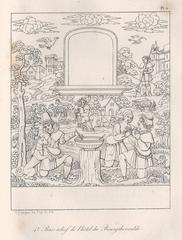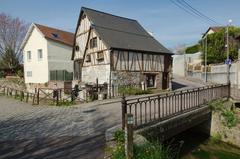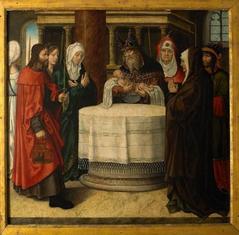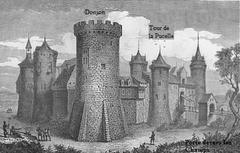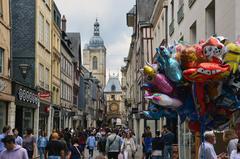
Fierte Saint-Romain Visiting Hours, Tickets, and Travel Guide in Rouen, France
Date: 04/07/2025
Introduction: Fierte Saint-Romain – A Cornerstone of Rouen’s Heritage
In the historic center of Rouen, France, the Fierte Saint-Romain stands as an enduring emblem of the city’s medieval and Renaissance legacy. This unique monument and its associated festivities trace their origins to the 7th-century legend of Saint Romain, the bishop credited with vanquishing the mythical Gargouille dragon. Through centuries of architectural splendor and civic tradition, the Fierte Saint-Romain has become both a historic landmark and the heart of Rouen’s most vibrant annual celebration: the Foire Saint-Romain (Visiterouen.com; Petit Futé).
Constructed in 1543, possibly by architect Jean Goujeon, the monument features Renaissance elegance with Corinthian columns and loggias. It is notable for surviving the devastation of World War II and remains a testament to Rouen’s resilience and identity (Monumentum). The Fierte is also closely linked to the “Privilège de Saint Romain,” a medieval tradition wherein the chapter of Rouen Cathedral pardoned a condemned prisoner each year—a powerful symbol of justice and mercy.
Today, the monument is at the heart of the Foire Saint-Romain, France’s second-largest funfair, held every autumn and attracting more than 1.5 million visitors (France 3 Normandie; Seine-Maritime Tourisme). This guide offers a thorough exploration of the Fierte’s history, visiting details, accessibility, and practical tips—essential reading for anyone wishing to experience Rouen’s most cherished tradition (Wikipedia).
Table of Contents
- Fierte Saint-Romain: History and Significance
- Visitor Information: Hours, Tickets, and Accessibility
- The Privilège de Saint Romain Tradition
- Architectural Highlights
- Nearby Landmarks and Guided Tours
- The Foire Saint-Romain: Modern Fair and Annual Events
- Travel and Accessibility Tips
- Frequently Asked Questions (FAQ)
- Summary and Essential Traveler Tips
- Sources and Further Reading
Fierte Saint-Romain: History and Significance
Origins and Legend
The Fierte Saint-Romain’s story is woven into the very fabric of Rouen. In the 7th century, Bishop Saint Romain is said to have tamed and subdued the Gargouille, a legendary dragon threatening the city. The word “fierte” comes from the Latin “feretum,” meaning a reliquary or shrine, and by 1036, the relics of Saint Romain were enshrined and became a focal point for public devotion and civic ritual.
Architectural Heritage
Constructed in 1543, the monument’s Renaissance architecture—characterized by stacked loggias and Corinthian columns—reflects Rouen’s artistic aspirations of the era. Its preservation through the centuries, including post-war restoration, makes it a rare survivor among the city’s Renaissance landmarks (Monumentum).
Visitor Information: Hours, Tickets, and Accessibility
- Location: Place de la Haute-Vieille-Tour, central Rouen, opposite the Halle aux Toiles.
- Exterior Viewing: The monument is outdoors and freely accessible at any time.
- Interior Access: The chapel is generally closed except for special occasions such as European Heritage Days. During these times, access may be limited and require advance booking (Petit Futé; Monumentum).
- Best Hours: Daylight, typically 9:00 AM–6:00 PM.
- Admission: Free for exterior visits; special event access may be ticketed.
- Accessibility: The site is in a pedestrian zone with paved streets. Rouen’s public transport (TEOR, buses, trams) offers easy access. Most areas are wheelchair-friendly, though some cobblestones and uneven surfaces exist.
The Privilège de Saint Romain Tradition
Each year, until the French Revolution, the chapter of Rouen Cathedral was granted the right to pardon a condemned prisoner on Ascension Day. This act was symbolized by a grand procession involving the relics of Saint Romain, and the prisoner’s release became a powerful civic ritual. Though abolished in 1790, the tradition’s legacy endures, celebrated in modern commemorations and remembered as a symbol of justice and community (Wikipedia; Visiterouen.com).
Architectural Highlights
- Facade and Loggias: The monument’s two-tiered loggias and Corinthian columns showcase refined Renaissance style.
- Sculptural Details: The white-stone facade features intricate carvings restored in the late 19th century.
- Preservation: Unlike much of Rouen’s historical fabric, the Fierte Saint-Romain survived WWII bombing and remains a prized example of civic Renaissance architecture (Petit Futé).
Nearby Landmarks and Guided Tours
While at the Fierte Saint-Romain, take time to explore:
- Rouen Cathedral (Cathédrale Notre-Dame): A Gothic masterpiece, open daily 8:00 AM–6:30 PM, with free entry and guided tours available (Wikipedia).
- Gros Horloge: The city’s iconic astronomical clock.
- Halle aux Toiles: A historic former market.
- Historial Jeanne d’Arc: An interactive museum exploring Joan of Arc’s legacy.
Many local tour operators include the Fierte Saint-Romain in their historical walking tours.
The Foire Saint-Romain: Modern Fair and Annual Events
The Foire Saint-Romain transforms Rouen every autumn (mid-October to mid-November) into a bustling festival. Held on the esplanade Saint-Gervais, it features over 200 attractions, food stalls offering regional specialties (croustillons, pommes d’amour), and live performances (France 3 Normandie; Seine-Maritime Tourisme).
- Hours: Daily, 10:00 AM–midnight; extended hours on weekends and holidays.
- Admission: Free; attractions are individually priced (3–15€).
- Transport & Parking: Ample parking, enhanced public transport, free shuttles, and bike stations during the event.
Travel and Accessibility Tips
- Public Transport: Rouen’s buses, trams, and the TEOR line connect all major sites.
- Parking: Limited in the old town—use designated lots or park-and-ride options.
- Mobility: Most fairgrounds and monuments are accessible, but check for uneven paving.
- Best Time to Visit: For lively festivities, visit during the Foire Saint-Romain. For a quieter experience, explore in spring or early autumn.
Frequently Asked Questions (FAQ)
Q: Is there an admission fee to visit the Fierte Saint-Romain?
A: No, viewing the exterior is always free. Interior access is limited to special events, usually also free or with minimal ticketing.
Q: Can I visit the chapel’s interior?
A: Only during special events like European Heritage Days. Confirm dates in advance on official sites.
Q: Is the monument wheelchair accessible?
A: Yes, though the surrounding area has some uneven surfaces.
Q: What are the top nearby sites?
A: Rouen Cathedral, Gros Horloge, Halle aux Toiles, and Historial Jeanne d’Arc.
Q: How can I attend the Foire Saint-Romain?
A: The fair runs mid-October to mid-November at the esplanade Saint-Gervais, with free entry and pay-per-attraction rides.
Summary and Essential Traveler Tips
- The Fierte Saint-Romain is a landmark of Rouen’s Renaissance heritage, rooted in legend and civic tradition (Wikipedia).
- The monument is freely accessible year-round; interior visits require special event access.
- The Foire Saint-Romain, every autumn, is France’s second-largest funfair and a vibrant celebration of local culture (Seine-Maritime Tourisme; France 3 Normandie).
- Combine your visit with nearby historical treasures and take advantage of guided tours for a deeper understanding.
- Plan ahead for event dates and accessibility needs, and rely on public transport for ease of travel.
Experience the living heritage of Rouen through the Fierte Saint-Romain—where legend, history, and community spirit converge.








